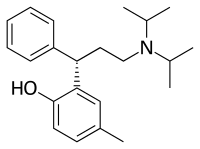Tolterodine
 | |
| Clinical data | |
|---|---|
| Trade names | Detrol, Detrusitol |
| AHFS/Drugs.com | Monograph |
| MedlinePlus | a699026 |
| Pregnancy category | |
| Routes of administration | By mouth |
| ATC code | |
| Legal status | |
| Legal status | |
| Pharmacokinetic data | |
| Bioavailability | 77% |
| Protein binding | Approximately 96.3% |
| Elimination half-life | 1.9–3.7 hours |
| Identifiers | |
| |
| CAS Number | |
| PubChem CID | |
| IUPHAR/BPS | |
| DrugBank | |
| ChemSpider | |
| UNII | |
| KEGG | |
| ChEBI | |
| ChEMBL | |
| ECHA InfoCard |
100.232.068 |
| Chemical and physical data | |
| Formula | C22H31NO |
| Molar mass | 325.488 g/mol |
| 3D model (JSmol) | |
| |
| |
| (verify) | |
Tolterodine (trade names Detrol, Detrusitol) is an antimuscarinic drug that is used for symptomatic treatment of urinary incontinence.[1]
It is marketed by Pfizer in Canada and the United States by its brand name Detrol. In Egypt it is also found under the trade names Tolterodine by Sabaa and Incont L.A. by Adwia.
Use
Detrusor overactivity (DO, contraction of the muscular bladder wall) is the most common form of urinary incontinence (UI) in older adults. It is characterized by uninhibited bladder contractions causing an uncontrollable urge to void. Urinary frequency, urge incontinence and nocturnal incontinence occur. Abnormal bladder contractions that coincide with the urge to void can be measured by urodynamic studies. Treatment is bladder retraining,[2] pelvic floor therapy or with drugs that inhibit bladder contractions such as oxybutinin and tolterodine.
Pharmacology
Tolterodine acts on M2 and M3[3] subtypes of muscarinic receptors whereas older antimuscarinic treatments for overactive bladder act more specifically on M3 receptors.
Tolterodine, although it acts on all types of receptors, has fewer side effects than oxybutynin (M3 and M1 selective, but more so in the parotid than in the bladder) as tolterodine targets the bladder more than other areas of the body. This means that less drug needs to be given daily (due to efficient targeting of the bladder) and so there are fewer side effects.
Side effects of tolterodine
Known side effects:
- Xerostomia (dry mouth)
- Decreased gastric motility (upset stomach)
- Headache
- Constipation
- Dry eyes
- Sleepiness
- Urinary retention
The following reactions have been reported in patients who have taken tolterodine since it has become available:
- Allergic reactions including swelling
- Rapid heartbeat or abnormal heartbeat
- Accumulation of fluid in the arms and legs
- Hallucinations
Contraindications:
Not to be used in patients with myasthenia gravis and angle closure glaucoma.
References
- ↑ Philip Van Kerrebroeck; Karl Kreder; Udo Jonas; Norm Zinner; Alan Wein (2001). "Tolterodine once-daily: superior efficacy and tolerability in the treatment of the overactive bladder1". Urology. 57 (3): 414–421. doi:10.1016/s0090-4295(00)01113-4.
- ↑ "Bladder retraining". Interstitial Cystitis Association. Retrieved 6 June 2018.
- ↑ Archived November 26, 2012, at the Wayback Machine.
External links
- Detrol - FDA factsheet
- Tolterodine